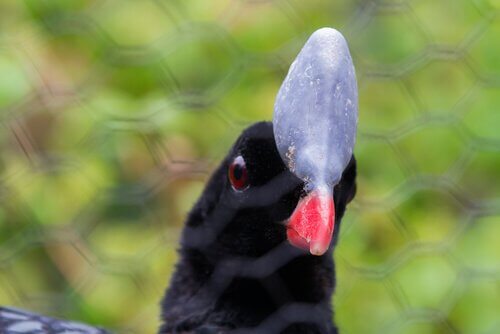The Helmeted Curassow: Bird in Danger of Extinction
The Helmeted curassow is a very strange bird that carries its skull in a bony helmet on top of its head. It lives in the southernmost area of South America in Venezuela and Columbia.
The helmeted curassow is of the Galliformes species and the Cracidae family, and its scientific name is Pauxi pauxi.
What are the characteristics of the curassow?
The helmeted curassow is a large bird that is between 33.5 and 38 inches in length. It has a bony helmet on top of its head, which is in the shape of a fig or a helmet and is grayish blue in color. This bony helmet measures about 3 inches in length.
The head and neck have velvety black feathers. Dorsal and side plumage vary from black to a very shiny black with green and blue reflections. Its abdomen is white, as is the end of its tail.
Even more colorful is its beak which is a dark red. Its eyes are brown and its feet are crimson.
Where does the helmeted curassow live?
In Venezuela, curassows live in the southwestern part of Santander and the northern part of Boyacá. There is a subspecies in the Sierra de Perijá.
In Venezuela, the curassow lives from the southern Sierra de Perijá to the Tucuco River in the state of Zulia. It also lives in the south of Táchira throughout the Andes of Mérida, Lara, Yaraucuy and to the east of Falcón, Cordillera de la Costa in Aragua, Carabobo, Capital District, Vargas and Miranda.
The curassow lives in dense cloud forests and mountain terrains. In addition, its range is from 1500 to 6000 feet above sea level. However, people have spotted them more frequently in cloud forests between 3000 and 4500 feet above sea level.
Behavior and reproduction of the helmeted curassow
These birds are active during the day and live in the forest. They don’t tend to fly much but will certainly do it when they feel threatened by a predator. In addition, they are territorial and live in family groups consisting of a male, female, and offspring. They eat mainly in the early morning and late afternoon.
During mating season, the male shouts a ventricular noise that sounds like the creaking of an old tree. Their call of alarm is a soft and repetitive “tzuk”. In addition to these noises, he also clucks, as a chicken does.
The mating season for the curassow is from January to July and they only raise one family a year. The female hides in the nesting area and generally nests are in tree branches entwined with vines.
Normally, the nests that they make are from 12 to 20 feet from the ground. It takes the females 4 to 6 days to construct the nest with branches and little dry sticks.
The females exclusively incubate the eggs for a period of 34 to 36 days. They are 5 inches long and 2 1/2 inches wide with a very hard shell. The males don’t go near the nest until the babies are born. Curiously, both the male and female care for the young.
Conservation of the helmeted curassow
Indiscriminate hunting and loss of habitat of this animal are the main threats. The (IUCN) International Union for the Conservation of Nature considers it an endangered species in its Red Book of threatened species. This is due to the fact that it’s in risk of extinction in the very near future.
In addition, it’s in Appendix III of the Convention on International Trade in Endangered Species of Flora and Fauna. However, this is only in Columbia. In Venezuela as well as Columbia, it’s listed in the Red Book.
These birds are very scarce in their natural habitat of Columbia and Venezuela. There exist less than 5 to 10 curassows for each square half mile. In total, this is less than 2500 mature birds in the world. Consequently, this species is in dire need of being protected to avoid extinction.
It might interest you...All cited sources were thoroughly reviewed by our team to ensure their quality, reliability, currency, and validity. The bibliography of this article was considered reliable and of academic or scientific accuracy.
Rojas-Suárez, F., Sharpe, C. J., Lentino, M. y Ascanio, D. (2015). “Paují copete de piedra, Pauxi pauxi”. J.P. Rodríguez, A. García-Rawlins y F. Rojas-Suárez (eds.) Libro Rojo de la Fauna Venezolana. Cuarta edición. Provita y Fundación Empresas Polar, Caracas, Venezuela.
